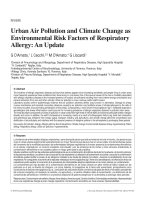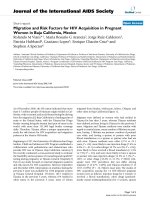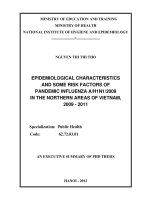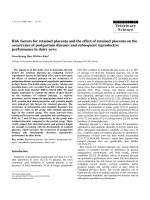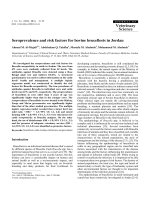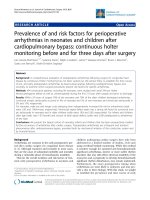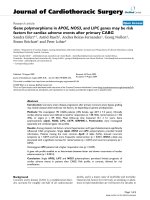Feeding and smoking habits as cumulative risk factors for early childhood caries in toddlers, after adjustment for several behavioral determinants: A retrospective study
Bạn đang xem bản rút gọn của tài liệu. Xem và tải ngay bản đầy đủ của tài liệu tại đây (344.19 KB, 8 trang )
Majorana et al. BMC Pediatrics 2014, 14:45
/>
RESEARCH ARTICLE
Open Access
Feeding and smoking habits as cumulative risk
factors for early childhood caries in toddlers, after
adjustment for several behavioral determinants: a
retrospective study
Alessandra Majorana1, Maria Grazia Cagetti2, Elena Bardellini1, Francesca Amadori1, Giulio Conti3,
Laura Strohmenger2 and Guglielmo Campus2,4*
Abstract
Background: Several maternal health determinants during the first period of life of the child, as feeding practice,
smoking habit and socio-economic level, are involved in early childhood health problems, as caries development.
The potential associations among early childhood caries, feeding practices, maternal and environmental smoking
exposure, Socio-Economic Status (SES) and several behavioral determinants were investigated.
Methods: Italian toddlers (n = 2395) aged 24–30 months were recruited and information on feeding practices,
sweet dietary habit, maternal smoking habit, SES, and fluoride supplementation in the first year of life was obtained
throughout a questionnaire administered to mothers. Caries lesions in toddlers were identified in visual/tactile
examinations and classified using the International Caries Detection and Assessment System (ICDAS). Associations
between toddlers’ caries data and mothers’ questionnaire data were assessed using chi-squared test. Ordinal logistic
regression was used to analyze associations among caries severity level (ICDAS score), behavioral factors and SES
(using mean housing price per square meter as a proxy).
Results: Caries prevalence and severity levels were significantly lower in toddlers who were exclusively breastfed
and those who received mixed feeding with a moderate–high breast milk component, compared with toddlers
who received low mixed feeding and those exclusively fed with formula (p < 0.01). No moderate and high caries
severity levels were observed in an exclusively breastfed children. High caries severity levels were significantly
associated with sweet beverages (p < 0.04) and SES (p < 0.01). Toddlers whose mothers smoked five or more
cigarettes/day during pregnancy showed a higher caries severity level (p < 0.01) respect to those whose mothers
did not smoke. Environmental exposure to smoke during the first year of life was also significantly associated with
caries severity (odds ratio =7.14, 95% confidence interval = 6.07-7.28). No association was observed between caries
severity level and fluoride supplementation. More than 50% of toddlers belonging to families with a low SES,
showed moderate or high severity caries levels (p < 0.01).
Conclusions: Higher caries severity levels were observed in toddlers fed with infant formula and exposed to smoke
during pregnancy living in area with a low mean housing price per square meter.
Keywords: Early childhood caries, Toddler, Feeding practice, Smoking exposure, Socio-Economic Status
* Correspondence:
2
Department of Health Science, WHO Collaborating Center of Milan for
Epidemiology and Community Dentistry, University of Milan, Milan, Italy
4
Department of Surgery, Microsurgery and Medicine Sciences – Dental
School, University of Sassari, I-07100 Sassari, Italy
Full list of author information is available at the end of the article
© 2014 Majorana et al.; licensee BioMed Central Ltd. This is an open access article distributed under the terms of the Creative
Commons Attribution License ( which permits unrestricted use, distribution, and
reproduction in any medium, provided the original work is properly cited.
Majorana et al. BMC Pediatrics 2014, 14:45
/>
Background
Breast milk is the ideal food for infants, providing all nutrients and antibodies that they require [1]. Feeding with human breast milk is considered to be the single most
important preventive intervention for infant survival. In developing countries, exclusive breastfeeding for the first six
months of life has been estimated to prevent 13% of deaths
each year in children less than 5 years old [2]. Breastfeeding
is defined as exclusive when no other supplement, such as
water, juice, non-human milk, or food, excepting drugs, vitamins and minerals, is administered to the infant [1].
The association between socio-economic factors like
maternal age, maternal education level, household income, mean cost of the housing in the area where the
family lives and infant feeding practice are complex and
may be even interrelated; in addition, the relations identified in bivariate analysis may not hold in multiple analysis and new association may be uncovered. Moreover,
it is really tricky to capture the material and financial aspects of SES. An inverse association is also reported: the
duration of breastfeeding was referred to be the highest
among the mothers of the lower income group followed
by mothers from the upper income groups [2]. Another
study reports that mothers with a higher level of education started breastfeeding and more continued for the
first 2 months after birth [3]. The literature on the determinants of breastfeeding has [3-5] consistently identified
maternal smoking as predictor of lower breastfeeding
rates. Babies whose mothers reported smoking during
pregnancy were less likely to be breastfed [6,7]. Moreover, the development of caries in children may be associated with prenatal maternal smoking and postnatal
environmental smoke exposure [8-11]. Maternal smoking during pregnancy appears to be a proxy for the
mother’s unhealthy diet and poor oral hygiene practices
[9-11].
Despite great efforts and achievements in oral health
promotion, caries remains a major childhood health
problem [12]. In Italy, as in the majority of industrialized
countries, recent data have revealed that caries is distributed unevenly, with the highest burden evident in underprivileged groups [13,14]; this situation highlights the
need for novel complementary strategies in caries prevention efforts.
The term early childhood caries (ECC) encompasses any
form of caries occurring in infants, toddlers and preschoolaged children [12]. The pattern of caries in toddlers aged
12–30 months is specific. Current evidence suggests that
the practice of nocturnal bottle-feeding with beverages containing sugar is the most important etiological factor in caries development [15]. Interactions among social, behavioral
and microbiological factors, including several risk factors,
also contribute to this process [13-18]. Epidemiological data
focusing on ECC prevalence in toddlers are scarce [19]. An
Page 2 of 8
association between ECC and breastfeeding has been proposed, especially when breast milk is consumed ad libitum,
in several daytime and nocturnal intakes, over a prolonged
period [20]. Milk residues that accumulate in the mouth,
promote caries development, especially during the night,
when the salivary flow rate is reduced; however, the results
of studies examining this association have been inconclusive [18,19].
Milk and milk products contain nutrients, such as calcium, phosphate, casein, and lipids, with potential anticaries properties [21]. In Italy, the daily consumption of
milk was associated with a lower prevalence of caries in
schoolchildren with no fluoride supplementation and
poor oral hygiene [22]. However, studies of the association between dairy product intake and dental caries in
young children have been rare, and the results have been
inconsistent [21,22].
The aim of this retrospective study was to investigate
the potential association between feeding practices, maternal and environmental smoking exposure and SES as
risk factors for caries development in toddlers aged 24–
30 months.
Methods
Study design and participants
The study was performed in the city of Brescia (Italy) and
was approved by the Ethics Committee of Brescia Hospital
(no. 298/2007). The metropolitan area of Brescia includes
about 1,210,000 inhabitants [], and
the fluoride content in tap water is low (0.12–0.05 mg/l)
[ />Mothers attending the two obstetric wards of Brescia
Hospital were enrolled between May 2008 and April 2009
(total number of births 3523). All mothers who gave birth
to a healthy child at full term (≥37 weeks of pregnancy)
with a birth weight ≥ 2500 g were invited to participate in
the study. Exclusion criteria were maternal diseases that
prevented breastfeeding, twin births and congenital oral
cavity malformation (e.g., cleft palate) in children (number
of eligible children 2623). An information leaflet explaining
the aim of the study and requesting consent to participate
was provided to the mothers. Only mothers who provided
written consent (n = 2610) were enrolled.
Between May and November 2010, the children were recruited; the appropriate size of the toddler sample was calculated on the basis of a previous study of caries prevalence
in Italian preschool children [5,12,14]. The previous sample
size was increased by 15% (to 2410 subjects) to ensure an
optimal level of precision (5%), given the possible effects of
caries prevalence reduction and non-response. A total of
2450 subjects aged 24–30 months were recruited and 2395
(1214 females [50.69%], 1181 males [49.31%]) were examined. The flow chart of the study design is shown in
Figure 1.
Majorana et al. BMC Pediatrics 2014, 14:45
/>
Page 3 of 8
Recruitment of the mothers
Number of births in the two obstetric wards of Brescia Hospital
3532
May 2008 – April 2009
Children fulfilled inclusion criteria
2623
Mothers with signed consent enrolled
2610
May 2009 – April 2010
Mothers fulfilled questionnaire
Clinical examination of the children
2517 questionnaire completed
May 2010 –October 2010
2450 children recruited
2395 children examined
1214 females
1181 males
Figure 1 Flow chart of the study design.
Questionnaire
Mothers were contacted by e-mail, and/or phone at six,
nine and twelve months after delivery and asked to
complete a self-administered, highly structured questionnaire with closed questions regarding feeding practices, infant’s sweet dietary habit, smoking habit during
pregnancy, environmental exposure of the infant to
smoke, and fluoride supplementation during pregnancy
and in the infant’s first year of life. The questionnaire
was standardized and previously used in a National
Pathfinder study showing a high reliability and validity
(Cronbach’s alpha = 0.92) [13]. In case of non-receipt of
the questionnaire, mothers were contacted by telephone
or email on a weekly basis up to three calls; in addition
unclear or incomplete answers were clarified through
telephone communication.
Feeding practices were classified using cut-off points
for the percentages of breast milk and formula administered to the infant at each meal. In the questionnaire
was asked to the mothers every six weeks to report for
three consecutive meals how many grams of each type
of milk was given to the baby. A mean of each type of
milk in the three meals was done and the values were
expressed in percentages [23]. The cut-off points were:
exclusive breastfeeding with 100% breast milk for
6 months, moderate–high mixed feeding with 58–99%
breast milk, low mixed feeding with 1–57% breast milk,
and exclusive use of formula (0% breast milk) [23].
Breastfeeding was also monitored at 9 and 12 months of
age. Sweet dietary habit was investigated by inquiring
about the administration of sweet beverages other than
milk (e.g., juice or other beverages rich in fermentable
carbohydrates) at 6 and 12 months of the infant’s life.
Maternal smoking during pregnancy was considered
positive when the mother reported smoking more
than five cigarettes/day. Environmental exposure to
smoke was considered positive when more than five cigarettes/day were smoked at home. Prenatal fluoride
supplementation (tablet/lozenge) was classified into
three categories: no fluoride supplementation, supplementation with ≥1 mg/day for ≤12 weeks of pregnancy,
and supplementation with ≥1 mg/day for more than
12 weeks of pregnancy [24]. Postnatal fluoride supplementation (drops) was measured by asking the mother
about the use of fluoride supplementation at 6 and
12 months of the infant’s life.
The mean housing price per square meter in the area
where the mothers live during pregnancy was used as a
proxy of SES [25,26].
Clinical examination
At the toddlers’ ages of 24–30 months, mothers were contacted by phone or e-mail and asked to bring their children
to the Department of Pediatric Dentistry of the University
of Brescia for clinical screening. Two calibrated examiners
(EB, FA) performed dental screenings using a dental unit.
Intra- and inter-examiner reliability was assessed before the
beginning of the survey by examining and re-examining
(after 72 h) sixty-five subsequent study participants. Interexaminer reliability was evaluated using fixed-effects analysis of variance in comparison with benchmark values
(GC). Intra-examiner reproducibility was assessed as the
percentage of agreement using Cohen’s kappa statistic [27].
Good inter-examiner reliability was found for the collapsed
Majorana et al. BMC Pediatrics 2014, 14:45
/>
ICDAS codes 1–3, 4 and 5–6, with no significant difference
from benchmark values (p = 0.21) and a low mean square
of error (0.44). Intra-examiner reliability was also high
Cohen’s Kappa statistic = 0.84.
Just before dental examinations, mothers brushed toddlers’ teeth. The presence of carious lesions was assessed
using a plain mirror and a World Health Organization
periodontal probe, under optimal artificial lighting. Carious lesions were evaluated using the International Caries
Detection and Assessment System (ICDAS) II criteria
during visual and tactile examination; no radiographs
were taken [28,29]. Following the ICDAS, decayed surfaces were coded as 1 when a first visual change in enamel, seen only after prolonged air drying or restricted
to within the confines of a pit or fissure (including noncavitated and cavitated lesions), was present; as 2 when a
distinct visual change in enamel was detected; as 3 when
localized enamel breakdown (with no clinical visual sign
of dentinal involvement) was observed; as 4 when a
underlying dark shadow from dentin was identified; as 5
when a distinct cavity with visible dentin was seen; and
as 6 when an extensive, distinct cavity with visible dentin
was discovered. Subjects were categorized according to
maximum ICDAS score as follows: low caries severity
level (1–3) referred to caries involving only the enamel
with no evidence of dentine involved, moderate caries
severity level (4) referred to caries involving enamel and
dentine, and high caries severity level (5–6) referred to
cavitated caries lesions.
Data analysis
Data were entered into a database (Excel 2010; Microsoft
Corporation, Redmond, WA, USA). Statistical analyses
were performed using Stata® 10.0 software (http://www.
stata.com). Responses to questionnaire items were treated
as categorical or ordinal variables. The mean housing price
per square meter in the area where the mother lives during
pregnancy [30] was used as proxy of SES. This parameter
was chosen because in Italy the majority of families (about
80%) live in their own home. The city of Brescia was divided into three different areas on the basis of the property
price: city center with houses at a mean price of Euro 2.750
per square meter; semi-central area with houses at a mean
price of Euro 2.140 square meter, and suburbs area at a
mean price of Euro 1.780 per square meter (http://www.
immobiliare.it/prezzi-mq/Lombardia/Brescia.html).
Associations between toddlers’ caries data, gender and
mothers’ questionnaire data were assessed using chisquared test. Ordinal logistic regression was used to analyze
associations among caries severity level (ICDAS score),
feeding practices, Socio-Economic Status and behavioral
factors. The Akaike information criterion (AIC) was used
to measure the goodness of fit of the statistical model.
Multicollinearity might sometimes cause problems with
Page 4 of 8
regression results. This problem was solved using the
DFBETA command in Stata, dropping the information that
have too much influence on the regression line. Anyway,
after the data elaboration, no statistical significant multicollinearty was observed and so it was decided to report findings without outliers [31]. Statistical significance was set at
α = 0.05.
Results
Data from 2517 questionnaires completed by mothers
and 2395 dental examinations of toddlers were included
in the analyses. Drop-out rates were low, as only 93
(3.56%) mothers submitted incomplete questionnaires
and 122 (4.85%) toddlers were not present at the time of
clinical examination or were excluded from the analyses
(Figure 1). The main reason for study drop-out was relocation of the family outside of the community (n = 54
[2.15%] mothers); in addition, 16 (0.64%) mothers did
not reply to the request to bring toddlers for examination, 30 (1.19%) toddlers were absent on the examination day, and 22 (0.87%) refused to undergo the
examination.
Caries was present (ICDAS score ≠ 0) in 80.84% of
toddlers; 48.60% had low caries severity level, 27.52%
had moderate caries severity level, and 4.30% had high
caries severity. Non-cavitated carious lesions were recorded most frequently (Table 1). The severity of caries
did not differ significantly by gender (χ2(3) = 3.37, p = 0.34;
Table 1). ICDAS scores were significantly lower in children who received higher proportions of breast milk (exclusive breastfeeding, moderate–high mixed feeding)
than in those who received lower proportions (low
mixed feeding, exclusively infant formula) at 6 months
of age (p < 0.01; Table 2). Mothers reported the continuation of exclusive breastfeeding at 9 months in 34.5%
(n = 203) of toddlers who were exclusively breastfed at
6 months. At 12 months, only nine toddlers were still
partly breastfed; ICDAS scores were 1–3 for all of these
subjects. Different feeding practices were significantly
associated with ICDAS scores (odds ratio [OR] = 6.75,
95% confidence interval [CI] = 6.00-7.58); moderate and
high caries severity levels were not observed in subjects
who were exclusively breastfed, whereas high caries severity level was predominant in children fed with
Table 1 Sample distribution according to gender and
severity of caries
Caries severity
Male n (%)
Female n (%)
Total n (%)
No caries
227 (9.47)
232 (9.69)
459 (19.16)
Low (ICDAS 1–3)
580 (24.22)
584 (24.38)
1164 (48.60)
Moderate (ICDAS 4)
328 (13.69)
331 (13.82)
659 (27.52)
46 (1.92)
67 (2.81)
113 (4.72)
High (ICDAS 5, 6)
χ2(3) =
Male vs. female:
3.37, p = 0.34.
ICDAS, International Caries Detection and Assessment System.
Majorana et al. BMC Pediatrics 2014, 14:45
/>
Page 5 of 8
Table 2 Distribution of caries severity according to behavioral and environmental factors
Caries severity (ICDAS score)*
No caries
Low (1–3)
Moderate (4)
Ordered logistic regression (n = 2395)
High (5, 6)
Total
0 (0)
588 (24.55)
Feeding practice (first 6 months)
Exclusive breastfeeding
240 (40.82)
348 (59.18)
0 (0)
Moderate–high mixed feeding
172 (23.40)
563 (76.60)
0 (0)
0 (0)
735 (30.69)
Low mixed feeding
42 (7.86)
180 (33.71)
311 (58.24)
1 (0.19)
534 (22.30)
Exclusively artificial formula
5 (0.93)
73 (13.57)
348 (64.68)
112 (20.82)
538 (22.46)
Sweet dietary habit
≤1/day
366 (21.11)
814 (46.94)
486 (28.03)
68 (3.92)
1734 (72.40)
≥2/day
93 (14.97)
360 (54.66)
173 (26.17)
35 (5.30)
661 (27.60)
No smoking
397 (20.74)
490 (25.60)
79 (4.13)
1914 (79.92)
Smoking habit
948 (49.53)
During pregnancy
25 (15.53)
53 (32.92)
62 (38.51)
21 (13.04)
161 (6.72)
Environmental exposure
37 (11.56)
163 (50.94)
107 (33.44)
13 (4.06)
320 (13.36)
Low
23 (3.27)
241 (34.23)
359 (50.99)
81 (50.99)
704 (29.39)
Moderate
130 (12.06)
717 (66.51)
209 (19.39)
22 (2.04)
1078 (45.02)
High
306 (49.92)
216 (35.24)
91 (14.84)
0 (0)
613 (25.59)
Mean housing cost (SES)
Log likelihood
p
OR (SE)
95% CI
−1956.14
<0.01
6.75 (0.40)
6.00–7.58
−2767.84
0.04
1.18 (0.10)
0.99–1.40
−1873.25
<0.01
7.14 (0.37)
6.07–8.28
−2414.70
<0.01
0.21 (0.21)
0.18–0.24
*N (%); percentages are calculated within each column.
ICDAS, International Caries Detection and Assessment System; OR, odds ratio; SE, standard error; CI, confidence interval.
formula (low mixed feeding, 58.43%; exclusively formula,
85.50%). The goodness of fit (AIC criterion) was
3920.29.
The frequency of sweet beverage feeding in the first
6 months was very low (3.05%), but 661 (27.60%) mothers
reported giving their children sweet beverages more than
once per day at 12 months of age. A significant association
(p < 0.04) was found between ICDAS score and the
provision of two or more sweet beverages a day (OR = 1.18,
95% CI = 0.99-1.40; Table 2). A high sweet beverages intake
by the children was also highly statistically significant associated to smoking habit (χ22 = 736.36 p < 0.01) (data not in
table).
Children whose mothers reported smoking five or
more cigarettes/day during pregnancy showed a higher
risk for the development of caries (p < 0.01). Smoking
habits (maternal during pregnancy, environmental exposure) were significantly associated with ICDAS scores
(OR = 7.14, 95% CI = 6.07-8.28; Table 2). No child with
high caries severity levels belonged to a family living in
high-cost house, whereas more than 50% of toddlers belonging to mothers/families living in low-cost house had
moderate or a high caries severity levels (p < 0.01).
Overall, 43.21% (n = 1127) of mothers reported the use
of fluoride supplementation during pregnancy; the
majority (n = 960) of these mothers reported using supplementation for less than 12 weeks of pregnancy. Prenatal fluoride supplementation was not associated with
ICDAS score; few (3.7%) mothers reported the postnatal
use of fluoride at 6 months, so this variable was excluded from the analysis (data not shown).
The estimates related to caries severity according to
mean housing cost, feeding practice and smoking habit
are displayed in Table 3 and in Table 4 without outliers.
All the models were statistically significant (p < 0.01).
Results displayed in Table 4 do not differentiate statistically significant from results displayed in Table 3. Feeding practice was the main risk factor associated to caries
severity, followed by smoking habit and SES. The goodness of fit (AIC criterion) was 4040.70.
Discussion
This study aimed to elucidate the potential associations
among feeding practices, maternal and environmental
smoking exposure and SES as risk factors for caries development in toddlers aged 24–30 months.
The health benefits of breastfeeding are widely recognized [1]; the majority of children in the present sample
had been exclusively or partly breastfed, as reported in
several northern European countries [32]. In this study,
early-life feeding practices were significantly associated
with dental caries severity (measured using ICDAS II
criteria). Caries scores in all ICDAS categories were recorded in all four categories of feeding practice, but the
highest caries severity levels were more likely to occur in
toddlers who had received lower percentages of breast
milk (low mixed feeding or exclusively formula). A diet
rich in non-milk sugars has been considered to be
Majorana et al. BMC Pediatrics 2014, 14:45
/>
Page 6 of 8
Table 3 Ordinal logistic regression estimation
Number of observation = 2395 Caries severity
Log likelihood = −2785.29 OR (SE)
χ2 = 2431.62 p < 0.01 p-value (95% CI)
Mean housing cost (SES)
0.34 (0.02)
<0.01 (0.30 – 0.38)
Feeding practice
7.57 (0.44)
<0.01 (6.77 – 8.48)
Number of observation = 2395
Log likelihood = −3655.37
χ2 = 691.47 p < 0.01
Caries severity
OR (SE)
p-value (95% CI)
Mean housing cost (SES)
0.24 (0.01)
<0.01 (0.22 – 0.27)
Smoking habit
1.66 (0.15)
<0.01 (1.38 – 1.99)
Number of observation = 2395
Log likelihood = −2772.91
χ2 = 2456.38 p < 0.01
Caries severity
OR (SE)
p-value (95% CI)
Mean housing cost (SES)
0.34 (0.02)
<0.01 (0.30 – 0.38)
Feeding practice
7.58 (0.44)
<0.01 (6.77 – 8.48)
Smoking habit
1.62 (0.16)
<0.01 (1.34 – 1.96)
Number of observation = 2395
Log likelihood = −2940.91
χ2 = 2120.38 p < 0.01
Caries severity
OR (SE)
p-value (95% CI)
Feeding practice
8.31 (0.47)
<0.01 (7.44 – 9.29)
Smoking habit
1.61 (0.15)
<0.01 (1.34 – 1.94)
Caries severity according to feeding practice smoking habit and mean housing cost (SES).
cariogenic for infants and toddlers [32]. In addition, the
early introduction of sugary foods and beverages is
known to lead to the establishment of a habit that persists over time [33]. In contrast, breastfeeding has also
been associated with an increased prevalence of ECC, although researchers’ opinions on this matter have
differed [8,14-18]. The evidence reported is quite inconclusive and the association has been found only in children receiving prolonged and nocturnal breastfeeding.
Moreover, a systematic review determined that no scientific evidence supports the cariogenic capacity of human
milk [19]. Contradictory results among studies may be
explained primarily by methodological disparities, such
as the use of different cut-off points for breastfeeding
[19,20].
In this study, caries in toddlers was associated with
maternal smoking during pregnancy, which might be
considered a proxy for unhealthy dietary and oral hygiene habits [9,11]. Environmental exposure to smoke
was also significantly associated with high caries levels
even it is probably that smoking during pregnancy is
likely to be underreported, which was slightly the case in
the population object of the study. Toddlers exposed to
smoke were also less likely to be breastfed. Furthermore,
Table 4 Ordinal logistic regression estimation without outliers
Number of observation = 2395 Caries severity
Log likelihood = −3902.84 OR (SE)
χ2 = 196.52 p < 0.01 p-value (95% CI)
Mean housing cost
21.72 (44.74)
0.13 (0.38 – 1230.24)
Feeding practice
1.54e-12 (3.51e-12)
<0.01 (1.76e-14 – 1.35e-10)
Number of observation = 2395
Log likelihood = −3974.17
χ2 = 53.86 p < 0.01
Caries severity
OR (SE)
p-value (95% CI)
Mean housing cost
188162.9 (349924.1)
<0.01 (4915.47 – 7202820)
Smoking habit
116.08 (233.24)
0.02 (2.26 - 5957.48)
Number of observation = 2395
Log likelihood = −3848.88
χ2 = 304.45 p < 0.01
p-value (95% CI)
Caries severity
OR (SE)
Mean housing cost
0.10 (0.01)
0.06 (0.00 – 1.01)
Feeding practice
7.36e-19 (2.02e-18)
<0.01 (3.41e-21 – 1.59e-16)
Smoking habit
4.25e+10 (1.033e+11)
<0.01 (3.77e+8 - 4.79e+12)
Number of observation = 2395
Log likelihood = −3852.00
χ2 = 298.20 p < 0.01
Caries severity
OR (SE)
p-value (95% CI)
Feeding practice
2.09e-17 (4.99e-17)
<0.01 (1.95e-19 – 2.25e-15)
Smoking habit
5.40e+9 (1.23e+10)
<0.01 (6.129e+7 - 4.63e+11)
Caries severity according to mean housing cost feeding practice and smoking habit.
Majorana et al. BMC Pediatrics 2014, 14:45
/>
the highest caries figures were observed in children fed
with infant formula and exposed to smoke (maternal
and environmental). To our knowledge, no study of the
effects of smoking exposure and feeding practice on the
risk ECC development has been reported previously.
Caries development in the primary dentition, especially
in very young children, is related to various social,
demographic, and behavioral factors, including SES [34];
differing aspects of SES may be associated with knowledge, attitudes, experiences, and beliefs leading a
woman to a particular infant feeding choice [35].
Fluoride supplementation during pregnancy was not
found to be significantly associated with toddlers’ caries
scores. Fluoride is recognized as a major factor in caries decline in many countries over the last several decades [12].
Dental hard tissue acquires fluoride systemically and topically; fluoride-rich enamel resists acid produced by cariogenic bacteria much better than does enamel lacking
fluoride [36]. Studies of the effect of fluoride exposure during the prenatal period have been rare, although it has been
shown to result in no additional measurable uptake by dental tissues other than that attributable to postnatal fluoride
alone [36-38]. In the present sample, prenatal fluoride exposure appeared to have no effect on caries risk profiles.
Furthermore, the effect of postnatal fluoride administration
(drops) to toddlers was negligible, and this variable was
consequently not included in the multivariate analysis. The
Italian National Guidelines on caries prevention in childhood, released by the Italian Ministry of Health in 2008 and
revised in 2013, leave to the pediatricians the choice to administer fluoride using a systemic or topical procedure and
this might be related to the negligible frequency of fluoride
supplement administered to the toddlers enrolled in this
study [39].
This study has some limitations. Feeding habits were
investigated during the first year of infants’ lives using a
self-administered questionnaire distributed to mothers
to reduce the possibility of recall bias. However, the effects of variables may have been attenuated, rather than
increased, by this method of data collection [37]. Secondly, fluoride intake from toothpaste was not considered. Third, the use of the mean housing price per
square meter as a proxy of SES might be criticized. For
example, low-income families living in high-income
neighborhoods have better access to health care than do
families with similar incomes living in low-income
neighborhoods [39]. However, given that more than 80%
of Italian citizens own houses [],
area-based measures can be used to investigate differences in SES [40]. Misclassification or underreporting
of the determinants of breastfeeding, and in particular
smoking status, may have led to residual confounding
resulting in a lack of an explanation for the association
observed between SES and breastfeeding. Moreover, only
Page 7 of 8
one aspect of the socioeconomic variables was measured, so it was not possible to rule out additional unmeasured effects of SES on caries data or on the other
caries risk factors. The results of the present study can
be generalized for populations with similar levels of risk
factors exposure.
Conclusion
In conclusion, a positive association among ECC, feeding
practice, smoking habits in the first six months of life
was verified. Furthermore the role of other important
risk factors was enlightened, like SES etc. No-exclusively
breastfeeding showed to increase caries severity and it is
very important that pediatricians are aware of these associations to direct toddlers at risk to the pediatric
dentists.
Competing interests
All authors declare that they have no potential conflict of interest.
Authors’ contributions
AM and LS conceived of the study and participated in its design; MCG
participated in the design of the study and drafting of the manuscript; EB
and FA collected data; GC organized dental examination appointments and
administered and collected questionnaires; and GCampus performed the
statistical analysis and was involved in the drafting of the manuscript. All
authors read and approved the final manuscript.
Acknowledgements
The authors acknowledge all parents who allowed their children to
participate in this study. This research was not supported by any specific
grant from any funding agency in the public, commercial, or not-for-profit
sectors.
Author details
1
Dental School, Department of Pediatric Dentistry, University of Brescia,
Brescia, Italy. 2Department of Health Science, WHO Collaborating Center of
Milan for Epidemiology and Community Dentistry, University of Milan, Milan,
Italy. 3IRCCS Ca’Granda University of Milan, Milan, Italy. 4Department of
Surgery, Microsurgery and Medicine Sciences – Dental School, University of
Sassari, I-07100 Sassari, Italy.
Received: 11 December 2012 Accepted: 11 February 2014
Published: 15 February 2014
References
1. Indicators for assessing infant and young child feeding practices, part 1:
definitions. />9789241596664/en/index.html.
2. Bharati SR: Socio-economic dimensions of breast-feeding-a study in
Hyderabad. Health Popul Perspect Issues 2000, 23:144–159.
3. van Rossem L, Oenema A, Steegers EAP MD, Moll HA, Jaddoe VWV, Hofman
A, Mackenbach JP, Raat H: Are starting and continuing breastfeeding
related to educational background? the generation R study. Pediatr 2009,
123:e1017–e1027.
4. Becker GE, Remmington S, Remmington T: Early additional food and fluids
for healthy breastfed full-term infants. Cochrane Database Syst Rev 2011,
7, CD006462.
5. Donath SM, Amir LH: The relationship between maternal smoking and
breastfeeding duration after adjustment for maternal infant feeding
intention. Acta Paediatr 2004, 93:1514–1518.
6. Inoue M, Binns CW, Otsuka K, Jimba M, Matsubara M: Infant feeding
practices and breastfeeding duration in Japan: a review. Int Breastfeed J
2012, 25:7–15.
Majorana et al. BMC Pediatrics 2014, 14:45
/>
7.
8.
9.
10.
11.
12.
13.
14.
15.
16.
17.
18.
19.
20.
21.
22.
23.
24.
25.
26.
27.
28.
Letson GW, Rosenberg KD, Wu L: Association between smoking during
pregnancy and breastfeeding at about 2 weeks of age. J Hum Lact 2002,
18:368–372.
Iida H, Auinger P, Billings RJ, Weitzman M: Association between infant
breastfeeding and early childhood caries in the United States.
Pediatrics 2007, 120:944–952.
Tanaka K, Miyake Y, Sasaki S: The effect of maternal smoking during
pregnancy and postnatal household smoking on dental caries in young
children. J Pediatr 2009, 155:410–415.
Hanioka T, Nakamura E, Ojima M, Tanaka K, Aoyama H: Dental caries in
3-year-old children and smoking status of parents. Paediatr Perinat
Epidemiol 2008, 22:546–550.
Shenkin JD, Broffitt B, Levy SM, Warren JJ: The association between
environmental tobacco smoke and primary tooth caries. J Public Health
Dent 2004, 64:184–186.
Petersen PE: Global policy for improvement of oral health in the 21st
century–implications to oral health research of world health assembly
2007, world health organization. Community Dent Oral Epidemiol 2009,
37:1–8.
Campus G, Solinas G, Strohmenger L, Cagetti MG, Senna A, Minelli L, Majori
S, Montagna MT, Reali D: Castiglia P and collaborating study group:
national pathfinder survey on children’s oral health in Italy: pattern and
severity of caries disease in 4-year-olds. Caries Res 2009, 43:155–162.
Congiu G, Campus G, Sale S, Spano G, Cagetti MG, Lugliè PF: Early
childhood caries and associated determinants: a cross-sectional study on
Italian preschool children. J Public Health Dent 2013. doi:10.1111/
jphd.12038.
Misra S, Tahmassebi JF, Brosnan M: Early childhood caries–a review.
Dent Update 2007, 34:556–564.
Vadiakas G: Case definition, aetiology and risk assessment of early
childhood caries (ECC): a revisited review. Eur Arch Paediatr Dent 2008,
9:114–125.
Psoter WJ, Zhang H, Pendrys DG, Morse DE, Mayne ST: Classification of
dental caries patterns in the primary dentition: a multidimensional
scaling analysis. Community Dent Oral Epidemiol 2003, 31:231–238.
Thitasomakul S, Piwat S, Thearmontree A, Chankanka O, Pithpornchaiyakul
W, Madyusoh S: Risks for early childhood caries analyzed by negative
binomial models. J Dent Res 2009, 88:137–141.
Mohebbi SZ, Virtanen JI, Vahid-Golpayegani M, Vehkalahti MM: Feeding
habits as determinants of early childhood caries in a population where
prolonged breastfeeding is the norm. Community Dent Oral Epidemiol
2008, 36:363–369.
Ribeiro NME, Ribeiro MAS: Breastfeeding and early childhood caries: a
critical review. J Pediatr 2004, 80:199–210.
Aimutis WR: Bioactive properties of milk proteins with particular focus on
anticariogenesis. J Nutr 2004, 134:989S–995S.
Petti S, Simonetti R, Simonetti D’Arca A: The effect of milk and sucrose
consumption on caries in 6-to-11-year-old Italian schoolchildren. Eur J
Epidemiol 1997, 13:659–664.
Scariati PD, Grummer-Strawn LM, Beck Fein S: A longitudinal analysis of
infant morbidity and the extent of breastfeeding in the United States.
Pediatrics 1997, 99(6):E5.
Brambilla E, Felloni A, Gagliani M, Malerba A, García-Godoy F, Strohmenger
L: Caries prevention during pregnancy: results of a 30-month study. J Am
Dent Assoc 1998, 129:871–877.
Geronimus AT, Bound J: Use of census-based aggregate variables to
proxy for socioeconomic group: evidence from national samples. Am J
Epidemiol 1998, 148:475–486.
Campus G, Cagetti MG, Senna A, Spano G, Benedicenti S, Sacco G:
Differences in oral health among Italian adolescents related to the type
of secondary school attended. Oral Health Prev Dent 2009, 7:323–330.
Castiglia P, Campus G, Solinas G, Maida C, Strohmenger L: Children’s oral
health in Italy: training and clinical calibration of examiners for the
National Pathfinder about caries disease. Oral Health Prev Dent 2007,
5:255–261.
Braga MM, Ekstrand KR, Martignon S, Imparato JCP, Ricketts DNJ, Mendes
FM: Clinical performance of Two visual scoring systems in detecting and
assessing activity status of occlusal caries in primary teeth. Caries Res
2010, 44:300–308.
Page 8 of 8
29. Honkala E, Runnel R, Honkala S, Olak J, Vahlberg T, Saag M, Mäkinen KK:
Measuring dental caries in the mixed dentition by ICDAS. Int J Dent 2011,
1504:24.
30. Hanley GE, Morgan S: On the validity of area-based income measures to
proxy household income. BMC Health Serv Res 2008, 8:79.
31. Bollen KA, Jackman RW: Regression diagnostics: an expository treatment
of outliers and influential cases. SMR 1985, 13:510–542.
32. Yngve A, Kylberg E, Sjöström M: Breast-feeding in europe–rationale and
prevalence, challenges and possibilities for promotion. Public Health Nutr
2001, 4:1353–1355.
33. Conn JA, Davies MJ, Walker RB, Moore VM: Food and nutrient intakes of
9-month-old infants in Adelaide, Australia. Public Health Nutr 2009,
12:2448–2456.
34. Chan SC, Tsai JS, King NM: Feeding and oral hygiene habits of preschool
children in Hong Kong and their caregivers’ dental knowledge and
attitudes. Int J Paediatr Dent 2002, 12:322–331.
35. Mobley C, Marshall TA, Milgrom P, Coldwell SE: The contribution of dietary
factors to dental caries and disparities in caries. Acad Pediatr 2009,
9:410–414.
36. Heck KE, Braveman P, Cubbin C, Chávez GF, Kiely JL: Socioeconomic status
and breastfeeding initiation among california mothers. Public Health Rep
2006, 121:51–59.
37. Sá Roriz Fonteles C, Zero DT, Moss ME, Fu J: Fluoride concentrations in
enamel and dentin of primary teeth after pre- and postnatal fluoride
exposure. Caries Res 2005, 39:505–508.
38. Marinho VC, Higgins JP, Logan S, Sheiham A: Topical fluoride (toothpastes,
mouthrinses, gels or varnishes) for preventing dental caries in children
and adolescents. Cochrane Database Syst Rev 2003, 4, CD002782.
39. Italian national guidelines on oral health in children. />portale/documentazione/p6_2_2_1.jsp?lingua=italiano&id=2073.
40. Hood E: Dwelling disparities: how poor housing leads to poor health.
Environ Health Perspect 2005, 113:A310–A317.
doi:10.1186/1471-2431-14-45
Cite this article as: Majorana et al.: Feeding and smoking habits as
cumulative risk factors for early childhood caries in toddlers, after
adjustment for several behavioral determinants: a retrospective study.
BMC Pediatrics 2014 14:45.
Submit your next manuscript to BioMed Central
and take full advantage of:
• Convenient online submission
• Thorough peer review
• No space constraints or color figure charges
• Immediate publication on acceptance
• Inclusion in PubMed, CAS, Scopus and Google Scholar
• Research which is freely available for redistribution
Submit your manuscript at
www.biomedcentral.com/submit
